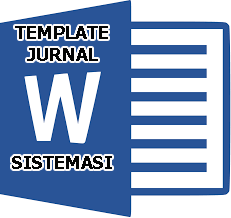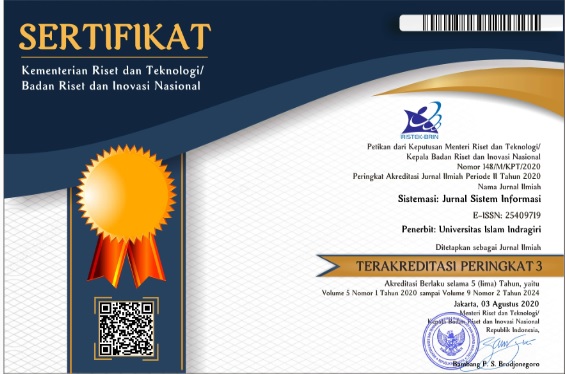Business Process Reengineering based on Information Economics
Abstract
Keywords
Full Text:
PDFReferences
M. Y. A. Alsabbah and H. Ibrahim, “HRM Practices and Employee Competence: A General System Perspective,” International Journal of Business, Economics and Law, Vol. 4, p. 1, 2014.
A. N. Indayanti, A. B. Atqiya, and B. Badrudin, “Education Human Resource Management in the Recruitment of Extraordinary Lecturers,” Munaddhomah: Jurnal Manajemen Pendidikan Islam, Vol. 3, No. 2, pp. 194–202, Dec. 2022, doi: 10.31538/munaddhomah.v3i2.262.
P. P. Rekrutmen terhadap Kinerja Karyawan pada Bank Perkreditan Rakyat Prisma Dana Manado Kamila Puliki, D. Sundah, and L. Lumatauw, “EKOMAKS : Jurnal Ilmu Ekonomi, Manajemen dan Akuntansi,” EKOMAKS |, Vol. 12, p. 226, 2023, [Online]. Available: http://ekomaks.unmermadiun.ac.id/index.php/ekomaks
J. S. and M. R. Ridho, “Perancangan Sistem Informasi Persediaan Suku Cadang untuk Alat Berat berbasis Desktop pada CV Batam Jaya,” Jurnal Comasie, Vol. 3, No. 2, pp. 1–9, 2020.
A. Mustafa, “Manajemen Sumber Daya Manusia berbasis Teknologi Informasi dan Komunikasi,” 2020.
M. Hammer and J. Champy, Reengineering the Corporation: Manifesto for Business Revolution. New York: A. Zondervan, 2009.
H. M. Osano and D. M. Okwena, “Factors Influencing Performance of Business Process Reengineering Projects in Banks in Kenya: Case of Kenya Commercial Bank,” Journal of US-China Public Administration, Vol. 12, No. 11, Nov. 2015, doi: 10.17265/1548-6591/2015.11.002.
F. C. Onwuchekwa and M. Ikon, “Business Process Reengineering (BPR) and competitive advantage in a Recessed Economy. A study of selected brewing firms in anambra state, nigeria,” 2018. [Online]. Available: https://www.researchgate.net/publication/334391623
S. S. Gadzali, J. Gazalin, S. Sutrisno, Y. B. Prasetya, A. Muna, and A. Ausat, “Human Resource Management Strategy in Organisational Digital Transformation,” Jurnal Minfo Polgan, Vol. 12, no. 2, 2023, doi: 10.33395/jmp.v12i2.12508.
P. A. Hamza et al., “Recruitment and Selection: the Relationship between Recruitment and Selection with Organizational Performance,” International Journal of Engineering, Business and Management, Vol. 5, no. 3, pp. 1–13, 2021, doi: 10.22161/ijebm.5.3.1.
A. M. A. Ausat and T. Peirisal, “Determinants of E-commerce Adoption on Business Performance: A Study of MSMEs in Malang City, Indonesia,” Jurnal Optimasi Sistem Industri, Vol. 20, no. 2, pp. 104–114, Nov. 2021, doi: 10.25077/josi.v20.n2.p104-114.2021.
J. DeGraff and D. Nathan-Roberts, Innovativeness as Positive Deviance. Oxford University Press, 2011. doi: 10.1093/oxfordhb/9780199734610.013.0053.
A. Sood and G. J. Tellis, “Technological Evolution and Radical Innovation,” J Mark, Vol. 69, no. 3, pp. 152–168, Jul. 2005, doi: 10.1509/jmkg.69.3.152.66361.
M. H. Arifin, “Analysis of Incremental Innovation and Radical Innovation on the Competitive Advantage of Lampit Product Msmes in the Wetland Area of Hulu Sungai Utara Regency,” Vol. 7, pp. 182–194, 2022.
E.J. Mishan and Euston Q, Cost Benefit Analysis, 6th ed. New York: Routledge, Taylor & Francis, 2020.
S. H. Roza, “Analisis Penyelenggaraan Sistem Pemeliharaan Peralatan Radiologi di RSUP DR. M. Djamil ,” Jurnal Kesehatan Media Saintika, Vol. 7, no. 2, 2016.
T. J. Crowe, P. Meghan Fong, T. A. Bauman, and J. L. Zayas-Castro, “Quantitative risk level estimation of business process reengineering efforts,” Business Process Management Journal, Vol. 8, No. 5, pp. 490–511, Dec. 2002, doi: 10.1108/14637150210449148.
DOI: https://doi.org/10.32520/stmsi.v14i5.5240
Article Metrics
Abstract view : 912 timesPDF - 92 times
Refbacks
- There are currently no refbacks.

This work is licensed under a Creative Commons Attribution-ShareAlike 4.0 International License.









